#alan jay factor
Explore tagged Tumblr posts
Text
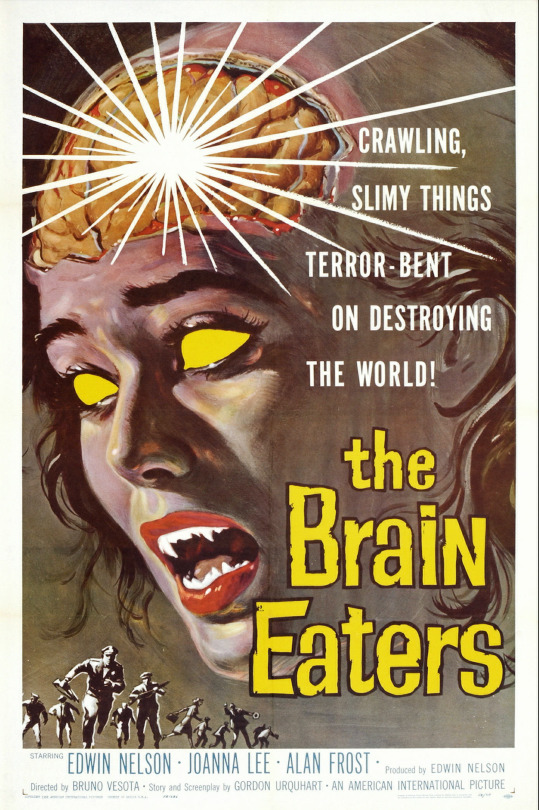
The Brain Eaters (1958)
#the brain eaters#ed nelson#alan jay factor#cornelius keefe#joanna lee#1958#1950s movies#1950s horror#1950s sci fi#bruno vesota#sci fi horror#aip#movie posters
133 notes
·
View notes
Note
I’m really curious as to your opinions on each of the Gatsby films. What do you think they did right/wrong? What do you like/dislike about casting choices? If you could make your ideal Gatsby movie rendition would you take any inspo from the existing movies?
(I would add the broadway musical into that list just for the heck of it but we all know that was just funky music loosely wrapped in Gatsby paper)
Oh good heavens...
Okay. So. I'll just talk about them in order of release. And again these are my OPINIONS !!!!!!!!!!!!!!!!!!!!!!!!!!!!!!!!!!!!!!!!!!!!!!!!!!!!!!!!!!!! THAT I WAS ASKED FOR !!!!!!!!!!!!!!!!!!!!!!!!!!!!! NO YELLING!!!!!!!!!!!!!!!!!!!!!!!!!!!!!!!!!!! I WILL CRY!!!!!!!!!!!!!!!!!!!!!!!!!!!!!!!!!
SO many spoilers ahead. You have been warned.
1926
Obviously this film is lost, but we have the trailer, photos, and Fitz's own reaction to it, which was to say he and Zelda left halfway through. It's not even based off the book, either, but based off a play based off the book, so one can imagine that given the filmmaking style of the time and its disconnect from the source material, it likely wasn't the most accurate adaptation.
Accuracy isn't everything in terms of what makes an adaptation 'good'—it's definitely a factor, though, along with entertainment value, justification for any alteration to the story, attention to detail, Genuine Caring For The Source Material, acting, casting, etc...all of these go into consideration, at least for me.
The casting seems alright for this version. Daisy has dark hair. Nick's taller than Jay and visibly, uhhhhhhhhh...well, like...have you ever heard of 'gay face'? But it ends about there, as Tom looks like he's 50, Jordan is...just not right, and as is often the case, Wilson is somehow beyond 'faintly handsome'? Do they just not have enough middies running around in Hollywood?
The costumes are obviously pretty accurate, though very clearly 1926 trying to do 1922. The skirts are. UP there. And I get that jay's shirts are monogrammed but a hand-sized monogram on each jacket? What? Did they think audiences would lose track of which brunette man was which?
Here's a photo. God nick is such a cunt look at him

I can't accurately give the whole film a rating but what I know of it gives it a 6.5/10. Bonus points to jay for pushing the no white shoes after labor day rule up to the very brink.
1949
...listen.
In terms of accuracy to the book, this is not the best. It's just not. It's a star vehicle for Alan Ladd who, at the time, was popping off hardcore in the film noir market, so they fiddle faddled with the tone a bit and shot it in black and white despite having access to color, amped up the crime (jay smokes some bitches in the first five minutes??? takes a hefty swing at a man at a party????) and then said uhhhhh what book are we adapting again?
East Egg and West Egg are scrambled, which goes against the whole 'east coast/old money' vs 'westerners/new money' thing. Nick and Jordan are married in the beginning before flashing back. Nick's just not hypocritical enough in this one, either, which is bothersome, because that's the whole point of his character in the novel—that he can't see his own faults for the more glaring faults of others.
They press fast forward a lot. Like there's no drive to new york or meyer lunch—nick and jay just snuggle in his boat watching the green light and jay tries to lie to nick and nick catches him immediately and jays like AH. YA GOT ME. HA HA. ?????????
if it weren't for alan ladd I would not watch this movie. Don't get me wrong, I love Macdonald Carey as Nick, but I think playing across from anyone else, this would be entirely forgettable and borderline unwatchable.
Alan Ladd. Alan Ladd. Where do I begin with Alan Motherfucking Ladd. This man is Jay Gatsby personified. I know that's controversial because 2013 has brainwashed people into thinking jay gatsby is over six feet tall, but there is something so distinctly perfect about casting a malnourished 5'7 midwestern blonde with such intense parental issues that he never recovered from the sickness that is an impoverished American childhood as jay gatsby. Alan Ladd was underestimated, spat on, put down from day fucking one. Every single time he got ahead in life he was cut down at the knees until finally, finally he found validation and celebrity in playing these soft-spoken, angel-faced killers onsreen. Only it wasn't enough. It was never enough. It could never fill that void and he could never get ahead of himself. You want to tell me that doesn't mirror the fuck out of Jay's life? You want to tell me there was a man in Hollywood at the time who could so deeply understand this character, even through the bullshit rewrites to try and mold the story into something it wasn't? There are even accounts of him taking reporters to his bedroom to show them his closet, saying 'not bad for an okie boy'. That's Jay. That's Jay in pure essence. Never having enough, and so excited to show what he had. Literally look into his past at all and you will mourn his lack of control over the direction the film took, because I know damn good and well if he had been more than just everybody's favorite film noir star at the time and a more respected name, he could have really pushed and pulled to peel back the story and pull better performances from the rest of the cast as a result.
Bonus points for having a really fucking weird Dan Cody and Ella Kaye. Both were distinctly, visibly, vocally predatory toward Jay and it's like the directors actually looked into prior drafts, even if I know damn good and well they didn't. I don't even know if they read the damn book.
Costumes were fine. I wish wish wish wish it had just been in color (THEY COULD HAVE DONE IT.) so that we could see if jay got his pink suit. I swear to god the sight of alan ladd in a pink suit would actually kill me.
I'll give this one a 7/10 overall, points dinging for accuracy to the novel and pacing and some really weird choices, like having jay come from the rainbow division in the war (????) to making nick like...offer to spank jordan. i don member THAT from the book. Most of these points come from Alan Ladd.
Uh. Here's myrtle getting hit by the car

1974
oh boy.
Where to begin? The film is a fucking mess. It's a goddamn motherfucking mess and I can only watch it if I cut Jay and Daisy out of it entirely, which is a shame, because I love both of their characters (for different reasons) but. oh my GOD.
So they got truman capote to write the screenplay at first. unfortunately he made nick and jay skinny dip, and jordan was a vindictive lesbian, and it was 1974 so they weren't about that noise at ALL. There's other stuff in that script too and it's honestly...not a great script to begin with, but that meant they had to REWRITE THE ENTIRE THING WITH JUST WEEKS TO GO BEFORE PRODUCTION. THEY ASKED FRANCIS FORD COPPOLA (THE GODFATHER.) TO WRITE IT AND HE DID IT IN THREE WEEKS IN A HOTEL ROOM, HAVING BEEN UNFAMILIAR WITH THE BOOK, THEN CLAIMED THEY DIDN'T EVEN USE HIS SCRIPT AFTER ALL??? HUH? HUH WHUH?
you can tell. oh boy you can tell. 'jay' and 'daisy' sit around talking in silent rooms for several minutes at a time, just...expositioning all over the place. it's...astonishing.
that's another thing. i...am aware mia farrow is a beloved actress and she did wonderful things onscreen in other films but she is totally and completely unwatchable as daisy. if I knew no other adaptation, she would make me hate daisy with a blind fucking rage. it's not even that she's a bad actress in this—she just does not fit the role even a LITTLE. she's shrill and loud and like...i don't know if she's on coke or what (I mean it's the 70s.) but she just whines and flails her way through the film in an entirely undaisy sort of way. like where is this girl with the sad, lovely face and the voice that's a deathless song? her voice isn't full of money in this, it's counterfeit. she owes me a debt for making me have to listen to her. she only got the job because her name was big at the time and she just asked for it and got it, no audition, no screen test, no nothing. i wish they would have switched lois chiles into daisy's role rather than have her playing jordan, because she was just a much better match for the character.
1974 has one of my favorite toms at least. I've said it before but he's got that sort of frustrated, unsatisfied disinterest, a sort of distraction about him that really lends well to the whole notion of forever chasing down his college days and all that.
WEIRD fuckin chester mckee in this one, but points for being the first fuckin film to show my man onscreen! there's even an elevator scene in this one but it's not between nick and chester, unfortunately. though there is immense sexual tension regardless.
SPEAKING OF NICK! SAM WATERSTON MY BELOVED!!!!
Yet again another flawless casting along the lines of Alan Ladd as Jay. He's such a bitch. I don't think Nick is the same if he's not a cynical gay little cunt some of the time and despite being apparently one of the nicest people in Hollywood, sam just GETS IT. HERE is someone who floats above reproach like his shit don't stink. HERE is someone who will throw the blame on just about anyone but himself—and has to let jay into that same bubble of protection. HERE is someone who knows he's useless but is too afraid to admit it to himself because he's turning 30 and is about to face a crisis of mortality. he's judgemental and critical and somehow pulls off the sort of mind-altering gay panic nick very explicitly experiences around jay every 5 seconds in prior drafts of the book. i wish you all understood how hot nick thinks gatsby is. i wish you all knew what I know. sam waterston knows. and he gets it. he also just looks like nick. like crooked teeth and awkward nose and all. that's nick. i wanna kick him in the shins.
i gotta talk about jay's house in this one. it's bad. why does he live in a greek temple. like. nick describes jay's house in the book. he does. he's a faux provincial palace. almost a fairytale castle. that's on purpose. why. is he living in a marble box. is it supposed to be a tomb. are you making death jokes. fuck you Robert Redford
speaking of Robert Redford. did anyone let him know who he was playing in the movie or did you just hand him a script and tell him to start wherever. I get that jay isn't known for his brains but I have never seen a more confused lead in a film does he even know the camera is rolling or does he do that naturally
costuming is unmemorable and inoffensive except

YOU CALL THAT PINK? PINK?
6/10. Saved by Sam Waterston. Rendered unwatchable by Mia Farrow.
2000
OH BROTHER THIS GUY STINKS
No seriously who let the BBC do this. 5 million dollar budget and they used 4.9 of it on jordan's fuck ass bob.
I don't even know where to begin. I guess I should start at the beginning. The movie opens to Jay dead in the pool, which is the best part of the movie because he's dead.
Nothing about this film is good. I...I hate to say that because I try to find a little good in every adaptation but holy CHRIST. I have only seen this one in parts because I physically cannot sit and watch the whole thing at once.
Nick is played by Paris from Romeo+Juliet. He's not good. Even the one scene I kind of sort of like, at the end where he burns all of jay's papers(?????) is kind of undercut because HE STILL WRITES THE BOOK?? THE EXPOSE??? WHY BOTHER??? HE'S ALREADY DEAD????
I don't remember tom in this. I barely remember Jordan, but she's really, really into Nick and it's kind of upsetting to watch from a visceral standpoint. It's very uncanny valley. That's a NotJordan. the real jordan would never.
it gets worse.
Whoever thought they should cast whatever his name is as Jay—death. death to all of them. That is the most smarmy, leering, dickweed of a dude I have ever had the displeasure of existing near. It's like if the jay equivalent of people who make hating daisy their entire personality got to design jay's characterization for this film. There are no good parts to him. It's just like every single person who's boiled him down to jUsT a CrEePy StAlKeR OWO got to write a film. i would even be down for that point of view if it was well-acted and well written but UNFORTUNATELY, THE ACTING BUDGET WENT TO JORDAN'S WIG,
I can't even remember. 1974 and 2000 blend together for me.
The costuming is so bad but like. whatever. i thought I could live with it.
until.
oh dear god why does daisy have 2007 hollister hair it's 1917
you get more than one photo this time because I know most people haven't seen this film

tell me this didn't come off a CW vampire show in 2011

IS THAT RENESMEE?

SMILEDOG IS THAT YOU?

THE HAIR?
and of course, jordan's 4.9million dollar fuckass bob

Like i get it. period dramas are hard. but good fucking god. im so uncomfortable looking at every single person in this film
BONUS:
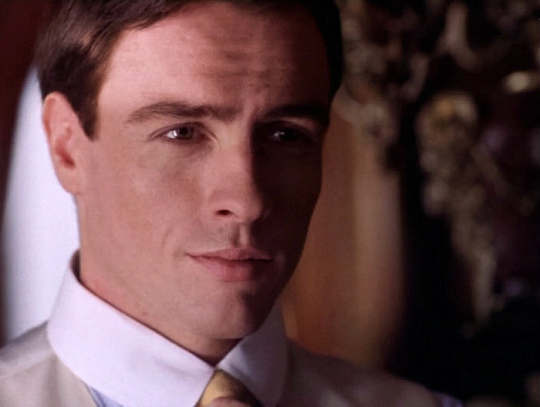

1/10 only because i get to watch NotJay die twice
i need a breather
...
2013
okay
In terms of direct, faithful adaptation, I think this one is the best. Like they didn't technically skimp on anything super major, didn't really try to put scenes in a blender. There's clearly, like. a whole script.
I'm already a Baz Luhrmann fan. I have been since the 7th grade when I saw this little movie called—
Romeo + Juliet. No, not tgg. I saw that next, though, and was obsessed. Love. Love!
I love when you can tell an adaptation is made by someone who actually cares about adapting the source material. Very key words there. Adapting. Source Material. Cares About. Because all of these other adaptations are clearly just looking to use a classic novel to make a movie but bazco clearly wanted to Adapt The Great Gatsby For Modern (At the time) Audiences.
I like a lot of the decisions made there. Casting an Indian actor as Meyer Wolfshiem—even if it goes against the explicit description of him in the book as this small beady eyed little weirdo, I think it was a better call to give a lesser-known (to American audiences) poc actor a role rather than continue digging the antisemitic hole Fitzgerald decided to dig himself for some reason.
The music too. It gets so much flack but I totally get what Baz was going for and it was honestly a little ahead of its time in 2013. To take a very White story (I could talk about the implications of Jay being mixed/black/otherwise poc all day) and apply our generation's equivalent of jazz ("oversexualized black people music") to forcing modern white audiences to face the fact that we absolutely will still sit here and find any reason to try and justify the erasure of black influence on the culture of America at any given point—it's chef's kiss. Shut the fuck up about it. I'm tired of hearing shit about the music being anachronistic. Yes, I would have loved to hear more period-accurate rejuvenated jazz covers in there. NO it would not be swing because hey bitch that too is anachronistic, it wasn't around in 1922. You can't have it both ways. Baz had a point to make and he teamed up with JAY Z to make it and yet again a bunch of white nerds got mad that they had to confront their internalized racism.
Yes, it is that deep. Everything is. To pretend it isn't is cowardice.
Anyway! The CGI pisses me off. It always will. If it's marvel or mordor I really don't give a damn, with that kind of budget you can afford some practical effects and save the CGI for moments where it can ACCENTUATE the practical effects to heighten the sense of mystification Nick undoubtedly felt upon entering this world. There's just no excuse for a lot of their effects and it's very disappointing to think of them trying to act in all these hollow blue environments.
Finally, FINALLY there's some depth to nick and jay's interactions. There's been this sort of disconnect in every other adaptation thus far and I'll give credit to Tobey Maguire and Leo DiCaprio for being friends for six thousand years before taking these roles, because the chemistry is Something Else.
that being said. tobey maguire was a really weird choice for nick carraway. I...don't really see it. I've called it Gooberfication before, as if they're sort of dumbing down his character and making him more palatable for the audience. I don't think it was an acting choice on Tobey's part but a choice made by the filmmakers themselves. There's no point in the book where Nick tries to make himself out as this friendly aw shucks ah geez scuse me ass goober, even when he's trying to claim he's like this unjudgemental dude. He lets you know outright that he'll do just about anything to get out of a conversation. He lies about his relationships, breaks up with people on a whim, is cynical and critical and has a barb to his tongue EVEN AROUND JAY (like when he considers asking to see Jay's rubies, knowing damn well he doesn't have any fuckin rubies.) And that's BEFORE jay dies. He's even worse after that, and I do appreciate the framing device of having Nick write this book while in recovery from...That Event.
which brings me to Baz Luhrmann Ships Natsby, Fuck You. He does. Oh my god. How are they queerer here than in actual fics I've written? Literal fireworks when they meet??? Nick being the one to call jay and hear the gunfire. that is his HUSBAND. "he did not know it (his dream) was already behind him" AS NICK STANDS BEHIND AN IMAGINED VERSION OF JAY. NICK HAVING TO PUT HIMSELF AWAY IN A MENTAL HOSPITAL AFTER GRIEVING HIM FOR YEARS???? BECOMING AN ALCOHOLIC INSOMNIAC WITH DEPRESSION, ANXIETY, AND FITS OF ANGER?????????????? BECAUSE HIS NEIGHBOR HE KNEW FOR THREE MONTHS DIED???????????????????????????? H. HELLO?
GOD.
Anyway. Speaking of their meeting, the song used in the background is Rhapsody in Blue by George Gershwin, which was professed by Fitz to have been THEE gatsby song, so that's a very nice touch. All the newspapers about Jay are written by prior Fitz characters. Even the clippings in Jay's scrapbooks attempt to add realism to the world but they...don't make sense entirely but that's fine. I know the filmmakers read at least Trimalchio but I don't know if they read the Princeton Draft. Either way, good on them.
Will never forgive this film for twinkifying Nick Carraway. Will never forgive it for planting the seed of top jay/bottom nick in the minds of the youth. I completely blame this movie for it. I don't think Jay was even topping Daisy at this point. He couldn't top a sundae. Even if he's played by Leonardo DiCaprio.
SPEAKING OF DAISY!!!!! I think Carey Mulligan did a damn good job at playing her accurately and as as much of a person as she could while still having the film's pov limited to Nick. Carey's a very good actor and she pretty clearly did her research to play Daisy, and was just very well cast. Now if the costume designers had simply allowed her to keep her natural hair color. Same with Jordan/Elizabeth Debicki. Daisy's brunette. Jordan's blonde. It's right there in the book in several places. I've talked about it forever. WHY would you go to the effort to change your actors' appearances when they were already accurate? Why? Why? Are you incapable of imagining a desirable woman who isn't blonde?
that being said, all jordan bakers should be 6'3. Elizabeth debicki, no notes.
tom's fine in this one. myrtle and George are too. chester actually gets to like. appear onscreen and try to get nick into the bedroom but UGGHHHHHHHHHHHHHHH of COURSE there's no elevator scene because nothing is ever fair or right or good. that's not MY chester (iykyk) but it is certainly A chester which is better than NO chester.
I would like to say that the Plaza scene in this film is the best of any of them. I believe beyond a shadow of a doubt that Jay was at a point in his health that if Wilson hadn't killed him, a heart attack would, and that's precisely the behavior exhibited in 2013's plaza scene. This is a man who has been twisting himself up into a tighter and tighter ball his entire life and has now just fucking sprung open because he's realized this is it, this is the end, everything I have done has been entirely pointless and I'm about the lose the one last fucking thing I have to live for and it's my fault because everything has been since the day I was born. Like I won't say it's 'mask off' and this would have been some sort of normal explosive behavior for him if he did end up getting to 'keep' daisy (because obviously shes An Object,,,,, right,,,,) but this...was coming regardless of whether tom dragged it out of him or not. it really exhibits just how much was going on behind the scenes that not even nick was privy to. just imagine how much pressure wolfshiem put on him in the end to keep going, keep working, as if his life isn't on the cusp of completely turning upside down.
(putting a space here because tumblr got mad about how much I wrote.)
that's one tiny little thing I absolutely adore about 2013. it's a blink and you'll miss it moment where meyer AND GOONS are in jay's office and he asks jay what's going on. It's so simple but so fucking menacing. it's so subtle. the implication that meyer has jay in a chokehold and the more time he spends with daisy, the more meyer gets pissed, and the more meyer gets pissed, the more likely he'll cut jay out of the business entirely, and jay's holding on to this tiny little string of assurance that he can manage it all for daisy and it's worth it for daisy and he's still the pretty face for the front of the company and meyer NEEDS him for that and if meyer needs him then it'll be okay, he can balance daisy and the business it'll be FINE—until it isn't, obviously. he originally turned daisy down when she suggested running away because all his money is tied up with meyer and if he runs, either meyer will track him down and kill him because he knows too much or he has to start over again. of course eventually he comes around to realize that running is their only option but it's too late and he knows that by the time he blows up at the plaza. he hit his breaking point and ruined everything. and leonardo DiCaprio is the only one who I think really captured just how fucking wound up jay really was.
I'm not talking about the broadway musical anymore
but if i were to make my own gatsby film...
I've never actually thought about it enough to pin down a cast. I have, however, considered that if for whatever reason I was given the opportunity to make any sort of adaptation of it, I'd probably have a black Jay regardless, and I think Ncuti Gatwa would be a really fun choice. Look at him. Imagine you're drunk and gay and this is across the table. Nick I get it.
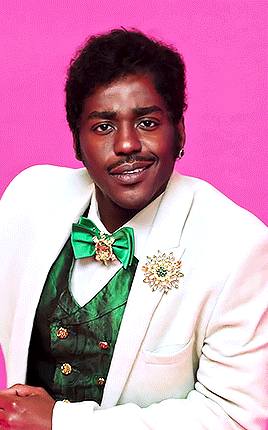
I would try to keep in line with the book as best I could, though, because it's important to me. I live and breathe the history of this novel and I can see all the lives woven into each minute detail and I would hate to not do it justice.
...
Otherwise...I do spend hours a day daydreaming about turning Gatsby into a limited series a la Anne with an E, albeit more adult in nature due to the subject matter. But I can see it in my head so clearly. I wish wish wish I could. Maybe one day. If only.
51 notes
·
View notes
Text
Grant Emerson's Lesser-Known Powers
The question from my quiz about Grant's lesser known powers is frequently missed, so I'd like to talk about what those are. While the explosions and inhanced strength and durability are his main and most recognizable skillset, he's got DNA from numerous members of the JSA and JLA, which gives him the potential to develop quite a variety of powers.
Here are the ones that got to turn up before later writers forgot about the possibilities set up in his solo.
Super Speed
This is one of the first powers of Grant's to manifest and the first one that we see in action, in his introductory scene. While trying out for the track team at his new school, he unexpectedly runs a mile in what the coach describes as "only a couple seconds off Olympic pace." Grant is surprised that he's suddenly "fast enough to try out to be the new Kid Flash." He's not a speedster, but he is able later on to keep up with speedsters like Impulse and Jesse Quick. This ability is probably due to his having DNA from three speedsters: Jay Garrick, Barry Allen, and Johnny Chambers.




(Damage #1, 13 / Titans 1999 #45)
Healing Factor
After dislocating an arm, Grant finds that he can heal it abnormally quickly. This power doesn't come up a lot, and I think writers have forgotten about it. Why, for instance, didn't it work when he was left with critical injuries that led to a disfigured face after the attack on his team? (Maybe since his powers do build and then fizzle out after being expended, he had already used up his charge by the time Zoom goes after him?)

(Damage #5)
Flight
While practicing on his own during his first time with the Titans, Grant accidentally finds out that he can use his energy blasts to propel himself through the air, although he has very poor control over it. Conversations with a version of his adult self from the future about his flight powers indicate that he will "be very bad at it for a very long time...if you live a long time." He continues to practice it and gets a bit better but still isn't confident about using it by the time he's with the Titans the second time. During the Sins of Youth arc, when he's aged up into an adult, he has perfect control of it. But he seldom uses this power during his short actual adulthood, which suggests that he still hasn't mastered it.






(New Titans Annual #11 / Damage #18, 19 / Titans 1999 #2 / Sins of Youth Secret Files and Origins #1)
Latent Telepathy
It takes Grant a while to find out that he has this power. It first manifests through dreams of the danger that his love interest Mandra is currently in, which turns out to be part of a mind connection that he has with Splatter, the creature who has kidnapped her. He has some resistence to mind control that shows up during an encounter with a supervillain in Washington D.C., but his powers aren't strong enough to completely ward off such attacks. He will learn that his latent telepathy comes from Martian Manhunter's being his primary genetic donor, and J'onn is able to communicate with him telepathically. When under attack from a telepathic virus, he is able to put up a lot of resistence, and although he will succumb to the control for a while, he's ultimately able to fight it off. We never see him use this power again; it's another one that writers have forgotten.








(Damage #9, 11, 19, 20)
The direction that Damage seemed to be taking when it was abruptly canceled was that Grant would be continually discovering new powers, and there's still a lot of unexplored angles on that. He has Atlantean DNA from Aquaman--would that come into play? (Titans 1999 missed the chance to develop this when Grant was frequently working with Tempest.) Could he develop more Martian powers, like shapeshifting, invisibility, or telekinesis? Does he have any Green Lantern-like powers like the ones Alan Scott's children inherited? Is he able to come back to life like Wildcat? Or have a canary cry like the Black Canaries or infrared vision like Doctor Mid-Nite? Could he shrink like the other Atom?
So many possibilities, with a lot of potential for difficulty thanks to the "elastic" quality of his DNA.
Apparently in the current continuity he has lost his powers, but what might happen when they inevitably are restored? Might be an opportunity to explore the possibility of his acquiring additional powers. DC will never do it, but it would be quite a story if they did.
8 notes
·
View notes
Text
Aca Top 10: Disney Villains — VoicePlay music video
youtube
Many actors contend that it's more fun to play baddies who get to indulge their darker desires without regret. The same often applies in musicals, whether they're on stage or screen. Disney knows how to craft a good villain song. These are some of their most fun, slick, seductive, and dastardly.
Details:
title: Aca Top 10 – Disney Villains
original songs / performers: "Friends on the Other Side" by Keith David as Doctor Facilier in The Princess and the Frog (2009); [0:33] "Mother Knows Best" by Donna Murphy as Mother Gothel in Tangled (2010); [0:50] "Trust In Me" by Sterling Holloway as Kaa in The Jungle Book (1967); [1:08] "The Siamese Cat Song" by Peggy Lee as Si and Am in Lady and the Tramp (1955); [1:28] "Oogie Boogie's Song" by Ken Page as Oogie Boogie in The Nightmare Before Christmas (1993); [1:52] "Cruella De Vil" by Bill Lee as Roger Radcliffe in 101 Dalmatians (1961); [2:16] "Gaston" by Jesse Corti as LaFou & Richard White as Gaston in Beauty and the Beast (1991); [2:50] "Hellfire" by Tony Jay as Claude Frollo in The Hunchback of Notre Dame (1996); [3:06] "Poor Unfortunate Souls" by Pat Carroll as Ursula in The Little Mermaid (1989); [3:25] "Be Prepared" by Jeremy Irons as Scar in The Lion King (1994)
written by: "Friends on the Other Side" by Randy Newman; "Mother Knows Best" by Alan Menken & Glenn Slater; "Trust In Me" by Robert & Richard Sherman; "The Siamese Cat Song" by Peggy Lee & Sonny Burke; "Oogie Boogie's Song" by Danny Elfman; "Cruella De Vil" by George Bruns & Mel Leven; "Gaston" by Alan Menken & Howard Ashman; "Hellfire" by Alan Menken & Stephen Schwartz; "Poor Unfortunate Souls" by Howard Ashman & Alan Menken; "Be Prepared" by Elton John & Tim Rice
arranged by: Geoff Castellucci & Layne Stein
release date: 22 March 2019
My favorite bits:
Layne kicking things off with scampering percussion before settling into a swingy groove
J.None showing off his smooth lower range
the vibratto Earl puts on that final high ♫ "motheeer" ♫
both Eli and Layne doing snaky hand motions during "Trust In Me" 🐍
Geoff's big bass drops on ♫ "ey-yyyes" ♫ and the final ♫ "meee" ♫
that crunchy harmony on ♫ "don't pleeease" ♫
all the shenanigans with the tiny kitty figurine 🐈
getting a preview of the "Oogie Boogie" production to come
that funky take on the second half of "Cruella"
the back row's dubious reactions to Geoff asserting his intimidation factor in "Gaston" as Layne fixes his hair
the extended transition — ♫ "Gimme hip-to-hip" ♫ ::Eli and J start flossing:: 🕺 "Chapstick!" ::Earl holds up a tube::
the clever coordination of ♫ "[tur]-ning me to" ♫ and ♫ "number two" ♫ at the end of "Hellfire"
Layne's bubbly percussion during "Poor Unfortunate Souls"
Earl getting annoyed at J and Eli joining him on the lyrics of "Be Prepared" before they return to harmonies
the three octave unison between Geoff and Earl
that nice clean ending
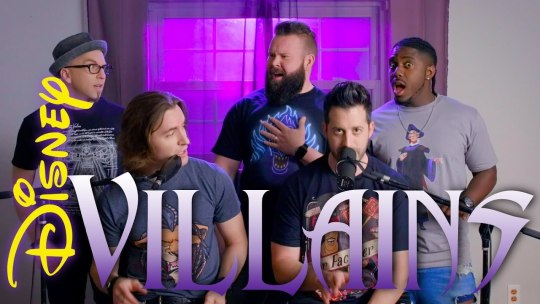
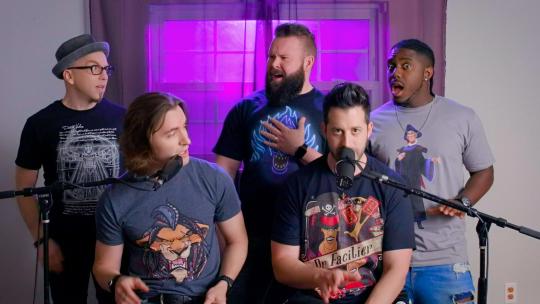
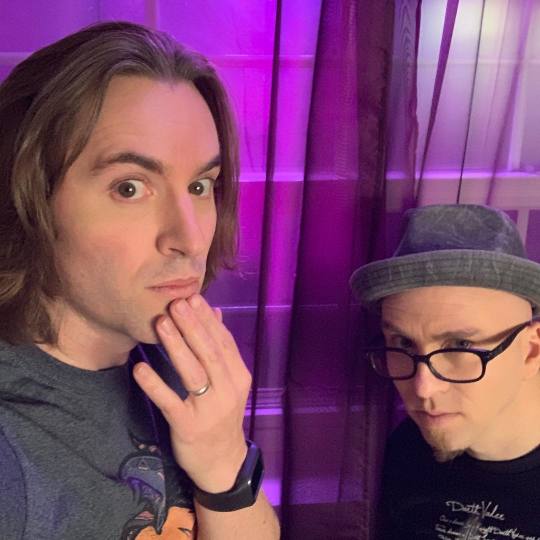
Trivia:
○ VoicePlay had recorded or performed several of these songs before.
They did a full version of "Cruella de Vil" in collaboration with Disney for the Diamond Edition release of 101 Dalmatians on Blu-ray. They also included an excerpt in their aca-Disney medley to celebrate 20 years of Disney shows on Broadway.
"Gaston" is part of their Beauty and the Beast medley, Tale As Old As Time, on their 2012 album "Once Upon an Ever After". (They also later included it on their 2024 compilation album "VoicePlay Villains".)
"Be Prepared" is part of their "OUaEA" Lion King medley, The King Has Returned. (That's also where the snippet over the end screen is from.)
"Mother Knows Best" was part of "The Story of Rapunzel" that they performed at Disney World's 2015 Social Media Moms Celebration.
○ They had also previously created a shorter villains medley including several of these songs for Jonathan Freedman as part of their Disney Sessions collaboration with the Aladdin stage cast.
○ Since this video was released, the guys have recorded longer versions of several more of these tunes.
"Friends on the Other Side" was their Halloween video for 2021, as well as their first reunion with J.None after he left to join the U.S. Navy Band.
"Oogie Boogie's Song" was their Halloween video later in this year.
"Poor Unfortunate Souls" was included in their Little Mermaid medley with Rachel Potter a year and a half later.
"Hellfire" was their Halloween video in 2023, also with J.None as the featured guest.
Geoff did a short of "Trust In Me" on his solo channel in 2024.
○ The guys' shirts are once again thematically appropriate.
Eli — Darth Vader from Star Wars in the style of Leonardo Da Vinci's "Vitruvian Man" drawing
Earl — the face of Hades from Hercules in blue and purple linework with yellow eyes and teeth, surrounded by blue flames, all with a glow effect meant to imitate neon lights
J.None — a full-body portrait of Claude Frollo from The Hunchback of Notre Dame with one hand extended to the side (I couldn't find the exact design, but I found one that's somewhat close and did a bit of editing to get it closer.)
Geoff — the stylized face of Scar from The Lion King
Layne — Dr. Facilier from The Princess and the Frog mirrored in the style of a playing card, with glowing red cards floating near his outstretched fingers and his name on a banner across the middle
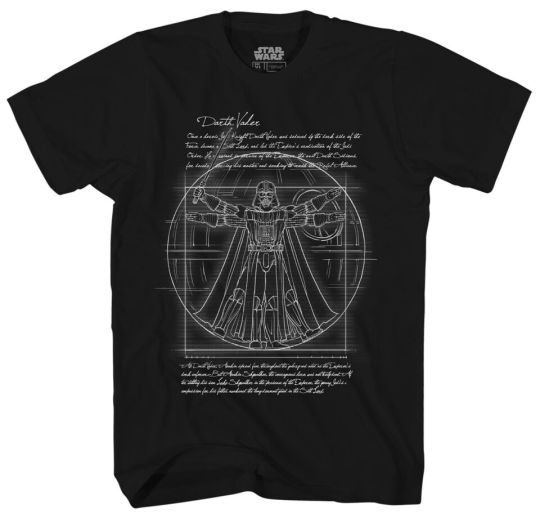

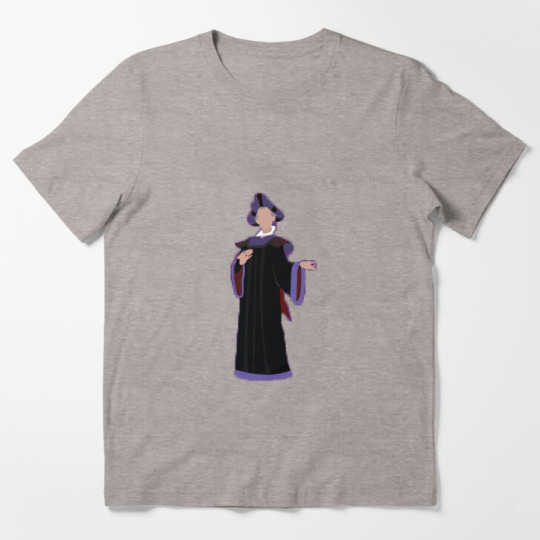

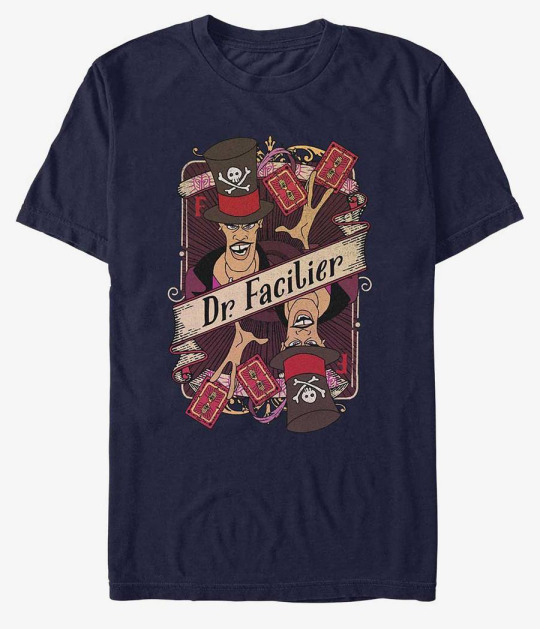
○ Geoff later mentioned in his interview on The Charismatic Voice that he'd considered auditioning for Gaston at Disney World when he worked there, but that the guys who play the role are usually four to six inches taller than him due to the costume and choreography required.
○ They garnered a bit of praise from prolific a cappella arranger Rob Dietz, who they'd met during The Sing-Off, and who would become a frequent collaborator in a few years.
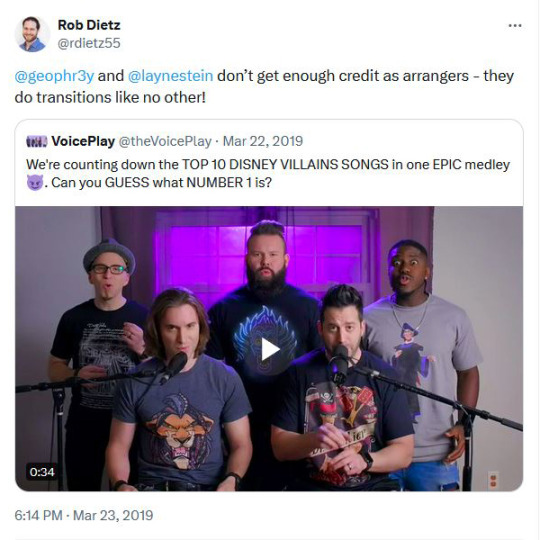
○ An artist fan was inspired to create a gender bent version of Cruel-Layne De Vil.

drawing by rtlndr_ on Instagram
○ The boys busted out some of their best evil laughs to further entertain their social media followers.
instagram
○ This is the final entry in a mini-series within their "Aca Top 10" series, which was preceded by countdowns for "Disney Heroes" and "Disney Sidekicks" over the previous year and a half.
#VoicePlay#music video#a cappella#live recording#Disney music#Disney villains#music from movies#music#video#series: Aca Top 10
8 notes
·
View notes
Text
THE BRAIN EATERS Reviews and free on Plex, Pluto TV, Tubi and YouTube
‘Crawling, slimy-things terror-bent on destroying the world!’ The Brain Eaters is a 1958 sci-fi horror film directed by actor Bruno VeSota (Invasion of the Star Creatures) from a screenplay written by Gordon Urquhart. The Corinthian Productions movie stars Ed Nelson (Devil’s Partner; Night of the Blood Beast; Attack of the Crab Monsters), Alan Jay Factor, Joanna Lee (Plan Nine from Outer Space),…
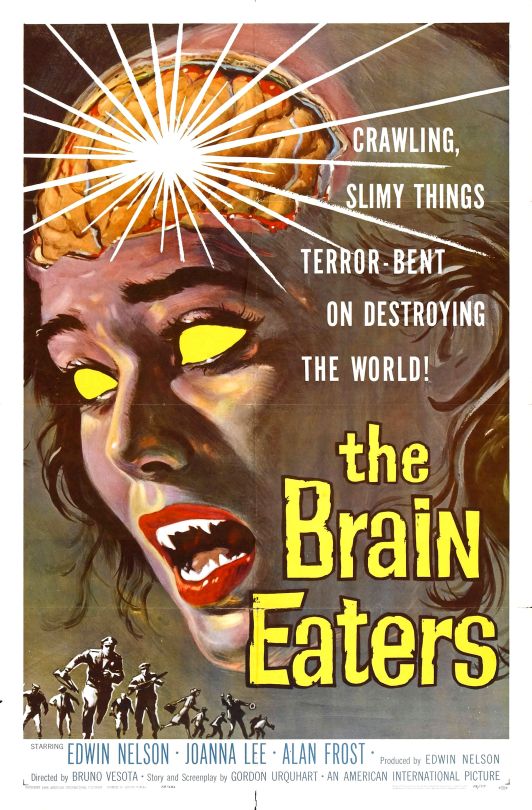
View On WordPress
#1958#alien#Bruno VeSota#Ed Nelson#free on YouTube#Leonard Nimoy#movie film#review reviews#sci-fi horror#The Brain Eaters
2 notes
·
View notes
Note
Do you have any Alan ships? Alan and Jared?
did you send this because you telepathically knew i was just on the verge of getting angry at all the alan/jay fan art in the tag im joking but great timing! i don't have any alan ships in the traditional fandom sense, i'm perfectly happy with what canon's offering us and basically taking it as it comes. however.
do i ship alan & jared? no, worse. i think there is a subtextual-but-canon gay thing afoot here. their dynamic makes me completely crazy deranged but that is because it's legitimately insane WITHIN the preexisting text.
now the whole deal is, which everybody who's read enough of alan (or all his appearances like me) can attest to, that alan scott does not show passionate emotions about anyone ever. sure, he gets good and angry about everything in the world, he's prone to absolute blind rage, he's had several mental breakdowns but they were all in relation to things. circumstances. he's cold and distant with most people outside of doiby dickles in the golden age. until 1994 he spent something like fifty-four years being cold and distant to people perceived as his closest friends. and then in the mid nineties after being suddenly aged down to his twenties by the starheart, after the effective death of the jsa, alan perplexingly decides to dedicate himself full-time to a completely inexplicable psychosexual obsession with one jared stevens called fate.
alan lies about the artifacts of fate belonging to him for no reason whatsoever. THIS IS AN INSANE CLAIM. and spends every minute of 1994-1999 trying to kill jared over the artifacts, which again do no belong to alan by any means whatsoever and i'm not entirely sure he'd ever had more than one single conversation with kent nelson. he sues jared over the artifacts through occult means which results in bringing him back to LIFE just so they can argue some more. he inexplicably keeps showing up wherever jared goes. he is so passionately deranged about jared it circles around to reading like something else entirely because it's not just uncharacteristic of alan... it's downright unheard of for him to have any sort of strong feelings about another person -- about another man -- even if that feeling is INEXPLICABLE VIOLENT HATRED.
and that's not even counting the fact that jared has a lot more in common with young alan than you might think -- social class dynamics, obvious gaycoding, antagonistic feelings about the superheroic world, uncommonly close to a male best friend being some of the more evident factors at play here. especially notable as by the time they meet, alan has spent a great big chunk of his life hiding & denying all of the above.
5 notes
·
View notes
Text

Jim Vallely Live on Game Changers With Vicki Abelson
Sitting down with Emmy and WGA award winner, Jim Vallely was a cozy, comfortable, fun, and funny hang. He even told us a joke joke, on request. It’s one he’s been “testing” as part of a sociological experiment of sorts. Win/win, we got a laugh with a lesson.
Who knew that having a seizure in 6th grade would lead to a career as a TV comedy writer. Jim takes us through and it makes perfect sense. This accountant studying student just happened to sit next to the right guy at an NYU audition, ask his mother the right question on the right day, marry the right girl, move into the right apartment, partner with the right actor/comedian, Jonathan Schmock, become 1/2 of The Funny Boys comedy team, appear on Johnny Carson, co-star on the sitcom, Double Trouble, and then write on The Golden Girls, one of the most successful sitcoms of all time. Brotherly Love, Ladies Man, Action, Two and a Half Men, My Wife and Kids, The John Larriquette Show, Till Death, Extended Family, as well as Arrested Development, for which he garnered 4 Emmy nominations, and the aforementioned awards, followed. Jim was an executive producer and co-creator with Will Arnett and Michael Hurwitz of Running Wilde on Fox. There’s more.
Jim tells a great Carl Reiner/Alan Brady story, tells us how the real Kramer, Larry David, Bill Maher, Callie Khouri, Chris Thompson, Don Reo, Mitchell Hurwitz, Will Arnett, and Jay Mohr factor into his story, gives us the before, during, and after of his career milestones, and speaks with great pride and tenderness about the great loves and joys of his life, his talented wife, Maggie, and his successful daughter, Tannis.
We talked about our friends, Taylor Negron and Ron Zimmerman. There is no friend like Jim. His love, devotion, and care for Ron, was a gift he gave all of us who loved him. Jim’s a tender-hearted, special man. And boy, is he funny. A very funny boy, indeed!
Jim Vallely Live on Game Changers With Vicki Abelson
Wednesday, 3/12/25, 5 PM PT, 8 PM ET
Streamed Live on my Facebook & YouTube
Replay here:
YouTube
#producer#comedian#TheFunnyBoys#JohnnyCarson#Funny#TheTonightShow#GameChangersWithVickiAbelson#VickiAbelson#GameChangers#podcast#inspirationalpodcast#Celebrity#FacebookLive#TalkShow#Chat#Live#comedy#music#talk#streaminglive#Interview
0 notes
Text
My TV isn't working i can't watch bird videos ( ; A ; )
I gotta decide if genetics are a factor in wing type in this au, or if it's like kind of random? If I go with genetics being a factor I gotta figure out how that works... I definitely want it to be something that can skip a generation or two if it's genetic
Below the read more is a long (and probably somehow still incomplete) list of characters I havent decided reference species for yet, if anyone wants to make any suggestions.
Alexei
Benny Hammond
Bob Newby
Carol Perkins
Dustin Henderson
El Hopper
Erica Sinclair (Lucas' reference species is a cooper's hawk and i haven't decided on their parents yet)
Jason Carver (some sort of eagle probs)
Jeff
Marshal (Freak 1)
Matty Cunningham (Chrissy's reference species is some sort of jay, i havent decided on either of their parents yet)
Mike Wheeler (Nancy's ref is a type of dove. No decisions ye for any other Wheelers)
Murray Bauman
Neil Hargrove (if this is inheritable, billy got his from his mom's side)
Patrick McKinney
Susan Hargrove
Tommy Hagan (probably a hawk, eagle, or other predatory bird)
Wayne Munson (Eddie's ref is a raven)
Will Byers (Jonathan's ref is a barn owl, and joyce's is a society finch)
Keith
Mr Harrington (Steve's ref is a crowned eagle)
Mrs Harrington (Steve's ref is a crowned eagle)
Phil Callahan
Phillip Cunningham
Sara Hopper
Sue Sinclair
Ted Wheeler
Tina
Tom Holloway
Alan Munson (Eddie's Dad)
Andy
Angela
Axel
Barbara Holland
Billy's Mother
Calvin Powell
Cathy Owens
Charles Sinclair
Claudia Henderson
Diane
Dmitri Antonov
Donald Melvald
Dottie
Earl
Eden Bingham
Elizabeth Munson
Fred Benson
Funshine
Holly Wheeler (Nancy's ref is a dove, the rest of the wheelers are undecided)
Janet Holloway
Kali Prasad
Karen Wheeler
Laura Cunningham
Lonnie Byers
Marissa
Marsha Holland
Martin Brenner
Melissa Buckley
Mick
Mr. Holland
Mrs. Walsh
Ms. Kelley
Reefer Rick
Richard Buckley
Sam Mayfield
Sam Owens
Tammy Thompson
Troy Walsh
Vecna/One/Henry Creel
Yuri Ismaylov
1 note
·
View note
Text
WEEK ONE Creative thinking and critical thinking
Creative practice and critical thinking are two essential skills especially for a graphic designer. Creative practice is the ability to use your imagination to generate new ideas, solve problems, and create new things. Critical thinking is the ability to analyse information, evaluate arguments, and make informed decisions.
For example, The Personal Computer is an innovative design idea by Alan Turing and Steve Jobs, needs critical thinking of key aspects of user experience, as improving user experience is important to most companies, designers, and creators when creating and refining products because negative user experience can diminish the use of the product.

I feel that these two factors are complementary with each other, for example when we are working on our other modules like studio, we have to use our creative practice to generate new ideas and then use critical thinking to evaluate our work and make the necessary changes. For our studio module, I am working on the baybeats festival and i have to use creative thinking on how to use different elements and choose a art direction that will work well with a music festival poster.
It is also important to have both factors inclusive in our working process. Furthermore if you develop on these skills, you can become a more effective problem solver and innovator. Some ways to develop these skills are to be more open minded while considering different perspectives and be willing to change your mind, be reflective about the creative process and identify which areas are needed for more improvement.
In conclusion, I think that if i do not have these 2 important skill sets I will not be able to do well in my studies nor go through my daily life commitments.
‘Critical thinking is the most important factor with chess. As it is in life, you need to think before you make decisions.' as quoted from Hikaru Nakamura an American chess grand master said, I agree with him as critical thinking happens in our everyday lives.
(1) Alan Martinez, Process Engineer
https://www.linkedin.com/pulse/critical-thinking-most-important-factor-chess-life-you-alan-martinez
(2)
JAY GREENE, August 11, 2011/Accessed on 17 November
https://www.cbsnews.com/news/the-computer-which-launched-the-pc-revolution/
(259 words)
1 note
·
View note
Photo

The Brain Eaters - 1958
Directed by: Bruno VeSota
Starring: Ed Nelson, Alan Jay Factor & Cornelius Keefe
#the brain eaters 1958#bruno vesota#ed nelson#alan jay factor#cornelius keefe#the brain eaters 1958 movie poster#1950s horror#50s horror#vintage horror movie poster#queen-of-mothra
155 notes
·
View notes
Photo
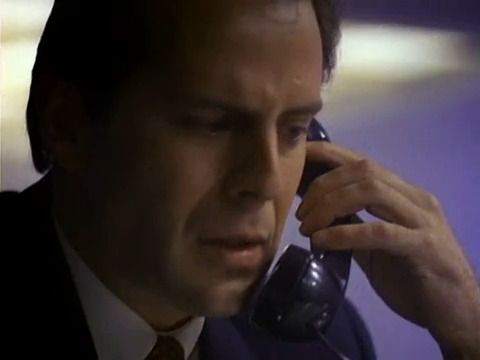
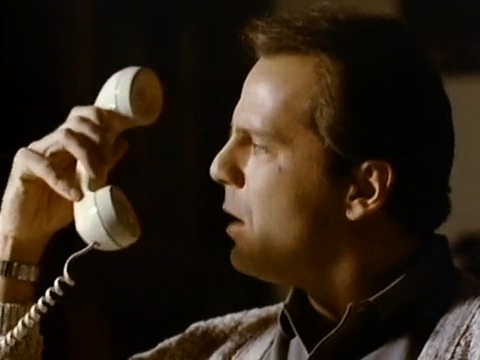
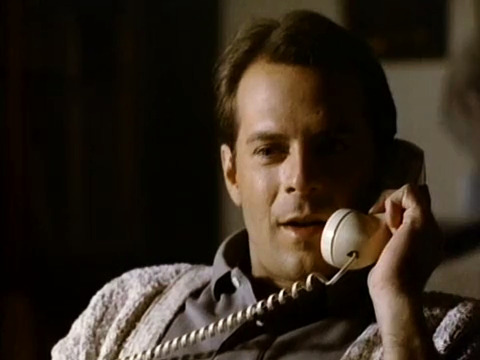


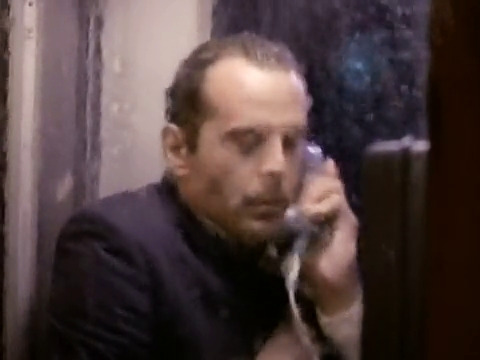


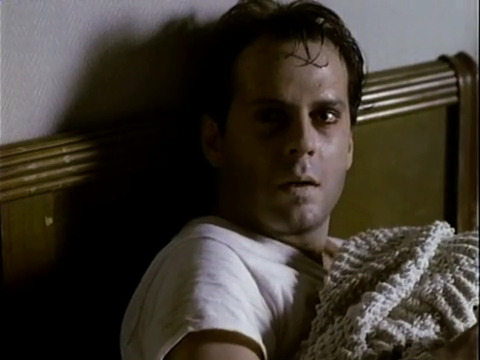

1.01a Shatterday
Director: Wes Craven
Writer: Alan Brennert (teleplay) & Harlan Ellison (short story)
Cinematographer: Bradford May
Opening Narration:
“Some push for what they need; some push for what they want. Some people, like Peter Jay Novins, just push. If they do it hard enough and long enough, something might just push back… from The Twilight Zone.”
Summary:
One night, in a crowded Manhattan bar, Peter Novins (Bruce Willis) distractedly makes the mistake of dialing his own phone number. In an unexpected turn of events, Peter Novins, having a cozy night in, answers the call. Over the course of the next few days, the two Novinses battle for ownership of his life. Novins #1 closes out his bank account and cancels his grocery delivery all while locked out of his apartment by Novins #2. Novins #2 meanwhile pulls out of a deal to do PR for an environmentally destructive company, and takes decisive steps to repair relationships with his mother and ex. As the days go by, Novins #1 shows distinct signs of illness and of wasting away, while Novins #2 becomes more vibrant and vigorous. Through phone conversations, the Novinses argue over what they’re experiencing, Novins #2 posits that Novins #1 had been leading a life filled with self-serving cruelties and that maybe this split was Novins’ personified last shred of decency taking a stand. In the end, when they finally meet face-to-face, Novins #1 comes to terms with his loss, and Novins #2 sympathetically casts off his old self.
Closing Narration:
“Peter Jay Novins, both victor and victim of a brief struggle for custody of a man’s soul. A man who lost himself, and found himself, on a lonely battlefield, somewhere… in The Twilight Zone.”
More about Shatterday:
One of the guiding principles at the conception of TZ ‘85 was that it was going to be a writer’s TV show. The writer’s voice was going to be paramount in the creative vision of the show. Alan Brennert, TZ ‘85’s Executive Story Consultant, chose the short story “Shatterday” by Harlan Ellison for adaptation. Ellison, who was already a big name in speculative fiction, had also been hired on as a Creative Consultant for the series. While Brennert wrote the teleplay for this episode, Ellison contributed to the script and was on set for filming. (Though Ellison stated later that he didn’t contribute much on set as he didn’t quite jive with the episode’s director, Wes Craven.)
Shatterday serves as a great kick off to the series—it shows so much promise in capturing that elusive Twilight Zone-iness. The story is effectively wrought with a lot of great visual storytelling elements to contrast the two Novinses. The music gives the right eerie discordant tones at the right moments. The character journey of Novins #1 is essentially grieving over the loss of his own life and Willis’ performance is pitch perfect. Willis captures the disbelief, anger, desperation, and resignation of Novins #1, while on the flip side capturing Novins #2’s calm determination.
Shatterday is a familiar type of speculative story for The Twilight Zone. A preternatural challenge to the natural order is introduced and the story then follows a person’s journey to cope with it and/or reevaluate their perceptions. A factor that I think is important to this type of story from the original TZ is its shorter length at ~24 minutes. When executed well, you are left with plenty to mull over or expand your imagination with, but it’s told in a short enough burst that too many thoughts of practicality don’t seep in and distract you from the point of the story.
The TZ ‘59 episodes that Shatterday most reminded me of were Nervous Man in a Four Dollar Room (S2E3) and In His Image (S4E1), particularly the element of someone choosing to make a foundational change in the way they live their lives necessitating the old version of themselves becoming just a memory.
✨Support✨
#Twilight Zone#the twilight zone#1980s#TZ '85#Philip DeGuere#alan brennert#harlan ellison#Shatterday#Wes Craven#Bradford May#bruce willis#cinematography#television#Classic TV#classic television#Classic Horror#Classic Science Fiction#speculative fiction#horror#Tv History#close up#close-up#New York City
11 notes
·
View notes
Text
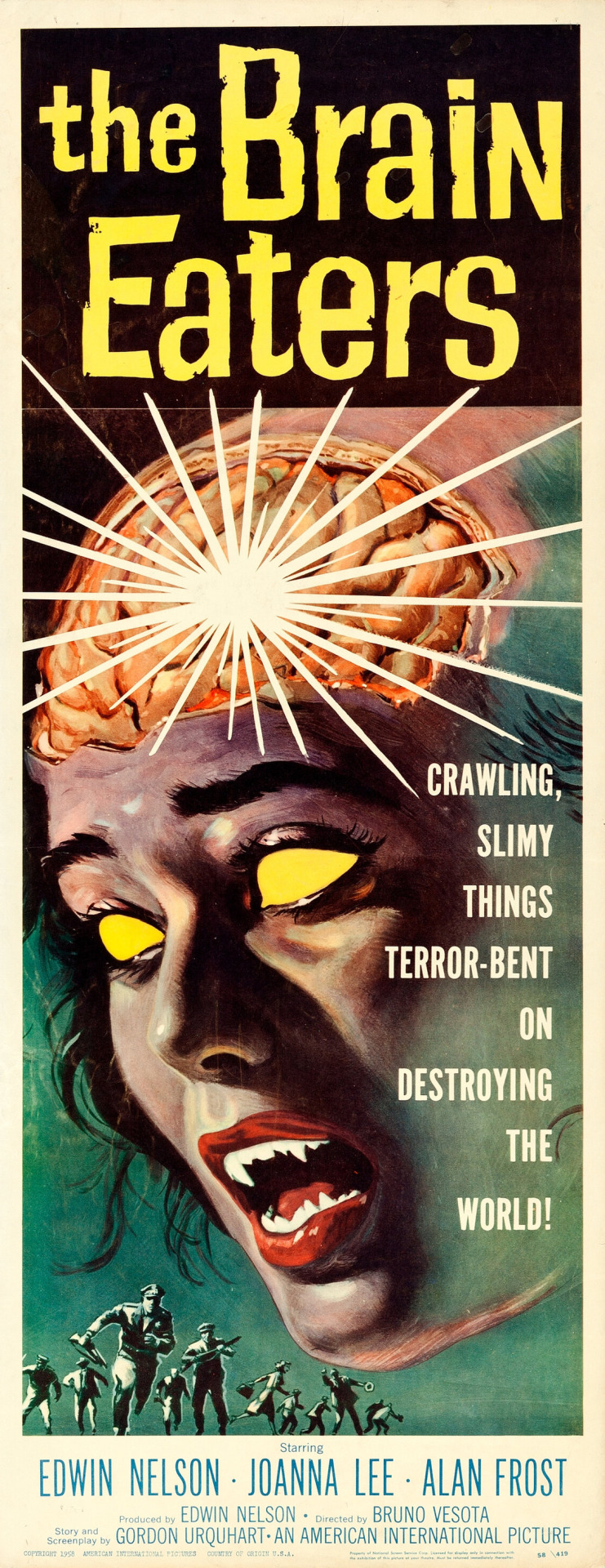
The Brain Eaters (1958)
#the brain eaters#ed nelson#alan jay factor#cornelius keefe#joanna lee#1958#1950s movies#bruno vesota#sci fi horror#aip#movie posters
94 notes
·
View notes
Photo

Screamin’ Jay Hawkins and Henry Soon after the release of "I Put a Spell on You", radio disc jockey Alan Freed offered Hawkins $300 to emerge from a coffin onstage. Hawkins initially declined, reportedly saying "No black dude gets in a coffin alive. They don't expect to get out!" However, he later relented and soon created an outlandish stage persona in which performances began with the coffin and included "gold and leopard-skin costumes and notable voodoo stage props, such as his smoking skull on a stick – named Henry – and rubber snakes." These props were suggestive of voodoo, but also presented with comic overtones that invited comparison to "a black Vincent Price." Despite the commercial success of the gimmick, Hawkins resented the schlock-factor that made him famous. He found it exploitative, and believed it undermined his sincerity as a vocalist and a balladeer. In a 1973 interview, he bemoaned the Screamin' epithet given to him by his label Okeh Records, saying "If it were up to me, I wouldn't be Screamin' Jay Hawkins. James Brown did an awful lot of screamin', but never got called Screamin' James Brown. Why can't people take me as a regular singer without making a bogeyman out of me?"
#screamin jay hawkins#i put a spell on you#coffin#voodoo#skull#vincent price#okeh records#james brown#bogeyman#shock rock#music history#r&b#rock and roll#music
155 notes
·
View notes
Text
Reviewing the All Elite Wrestling personnel 2022 Edition (Part 3) -
Part 0 - https://dreadwhoop.tumblr.com/post/697331836428353536/reviewing-the-all-elite-wrestling-personnel-2022
Part 1 - https://dreadwhoop.tumblr.com/post/697332640769081344/reviewing-the-all-elite-wrestling-personnel-2022
Part 2 - https://dreadwhoop.tumblr.com/post/697333058207154176/reviewing-the-all-elite-wrestling-personnel-2022
REMOVE
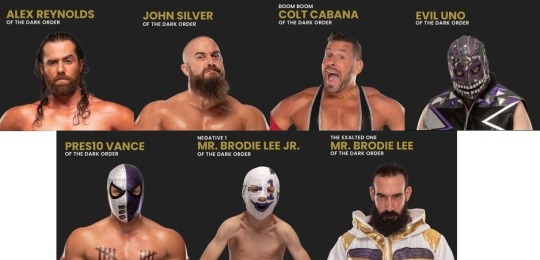
After their failure to rebrand themselves as The Dark Riders with Adam Page, The Dark Order has floundered for any relevance beyond beating The Factory over and over on AEW Dark. Had Stu Grayson and Anna Jay still remained this would be a harder sell but with Alan Angels also gone and Colt Cabana exiled from on-screen duties, the cast is down to its most pointless and fruitless members. Let me be the first to say I have all the respect in the world for a company putting on a tribute show to the untimely demise of one of their top talents who deserved better. However, with all due respect, if Jon Huber were alive today he'd of died from embaressment. The company has treated The Dark Order like a joke and never as any kind of creditable threat but when you factor in Pres10 Vance is FOURTH PLACE IN THE OVERALL WIN LOSS RATIO over Wardlow or Powerhouse Hobbs then no...I already made justifications to get rid of John Silver on his own terms. People who are happy to be there and not to be stars should go. The whole group is a farce and in shambles. The House of Black was simultaneously a better and less successful version of the whole thing. They're in shambles too. This whole group is a waste of time and effort let it end.
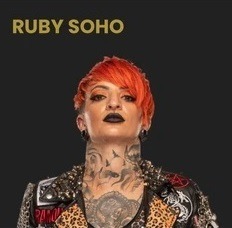
What a difference a year makes. AEW's biggest dissapointment. Ruby Soho deserved a chance to shine - she was being held back right? She got opportunity after opportunity and in the end fell flat. Literally falls flat - her finisher, No Future, either whiffs or has the effectiveness of an enziguri hit by a decayed sloth. Loses to the Women's Champion, loses her chance to be the first TBS Champion, and continues to be a loser where every win holds better talent back. It's embaressing to see her be so worried about what she does in the ring and her win over Kris Statlander in the Owen Hart cup cemented the tethering of patience AEW fans had waiting for her to justify beating better talent. I groan every time she shows up and now, thanks to Tay Melo, may not be showing up much at all. A tragic and cautionary tale as to why you don't hire every Ex-WWE person.

Why did Santana have to be the one injured and not this guy?! It's just not fair. Ortizitious is a condition involving the tongue being unfurled from the mouth and past the lips of the victim and then 'pants' or otherwise 'wags' the exposed muscle in front of everyone until you have the reflex to retract until the next time you are afflicted with said condition. Ruby Soho is a big sufferer of this but so are many others. Never forget Ortiz started all this. Ortiz deserves the door he's incredibly boring to watch at best and infuriating any other time.

Under normal circumstances an injured wrestler shouldn't be cut for these reasons but with Darius the true detriment is how much he'll hold his brother back as a tag-team. He can't be trusted to wrestle in any capacity than a supporting role and yet he's not needed here either. He's no Kris Statlander or others sidelined with injuries. He's a waste of promotion. Sorry Dante but he's no good. Cut him.
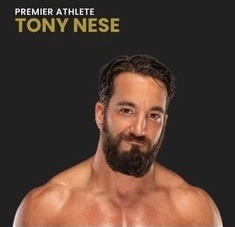
The world's most boring wrestler. A poor man's Pac. No direction, no promo ability, no psychology, no fundementals, no crowd reaction, nothing but a good looking body and an average height to stake a claim on. Jonathan Gresham has everything this man has and he's been marginalised. Tony Nese teams with a guy called Josh Woods who overshadows him in every way and you could argue he's painfully average in presentation. It's ridiculous this guy still has a job. At least with jobbers like Fuego or Peter Avalon the presentation has some comedy to it. Tony Nese is just a lost cause.

Do I need a reason? Aside from what happened recently, AEW has long needed to dismantle one of the most damaging examples to modern tag-team wrestling. Everyone will say they hold FTR back, trying to turn them into the modern day Doug Furnas and Philip LaFon and, whilst true, you have to also understand they also held back Private Party's momentum and now they're jokes, The Butcher and The Blade, who aren't taken seriously, and even Best Friends or SCU or Dark Order or Jurassic Express or any tag-team. Any. Out of the 8 teams to hold this belt in 3 years only 5 still exist including The Young Bucks. It's why The Acclaimed and Swerve in our Glory has proven not only are Matt and Nick Jackson not needed but they're not missed either. They're so insecure they didn't even let Brandon Cutler come out, even as a joke, for the House of the Dragon episode in terms of who would be their 3rd partner in the trios tournament. Oh and how could anyone respect a person after losing a fight to a guy who had a torn pec? Nobody should put these guys over ever again and, as the biggest reason why AEW has problems right now, they need to be held accountable and be fired or become the jobbers they've made everyone else barring The Lucha Bros. Don't come back.

It's time to hang it up. Matt's sad tribute act was due to his brother who is a foregone conclusion in terms of also leaving. Matt has no business on TV anymore - he can be a backstage agent like Christopher Daniels. Stiff knees, dazed looks, tough as nails I'll give him this, but he's hard to look at - a shell of his former self. Why give him wins? He has less chance of being a big star than Dustin Rhodes does these days. Manage talent, be on commentary, just please stop wrestling. I'd rather see Mark Henry or Paul Wight in the ring which is to say I'd rather not them either. Retire with dignity before it's too late.

The prophecy is incomplete but I cannot wait another year. The time has come. We got part 1 completed with him winning the tag titles with Jungle Boy. Now all he needs to do is finish it with putting Jungle Boy over and we're done with this doofus. The fact this guy nearly ended Rey Fenix's career should be enough reason to remove. Every year he almost gets the cut but I stay the execution well now his time has come.

You probably forgot she even existed. It's worrying to think at one point they were contemplating her being a serious contender for the Women's title. Did you know she beat Kris Statlander on a PPV this year? Like Red Velvet, Leyla was never destined for greatness and her complete lack of charisma or presence makes it the kind of deal I worry she'd be inserted into the BCC instead of Jamie Hayter. Get rid of this charisma vacuum and channel changer.
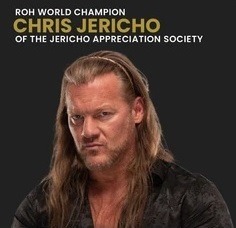
If MJF calls himself The Devil then Chris Jericho is Keyser Soze. The greatest trick The Magician pulled is letting everyone call him The Wizard because he sure has pulled the curtain over us all. A masterful conspiracy has played out where Jericho has resurfaced as a top talent, because he's booking his own segments, whilst latching onto every big name and fan-favourite until they're squeezed out of relevance. Everyone from Santana to Orange Cassidy to Eddie Kingston to even MJF - the list goes on and on - and not once was it to benefit them because who is still being booked at the top whilst the rest follow behind? The man with the master plan. Look at the past at who I've slated to remove - 2.0 to Jake Hager to others latched onto Jericho. Is it any wonder why Jericho has to go now? Look Chris Jericho is a good wrestler - he still can go - but this is it. He's done it all. It's all played out. He's the last of a generation where his contemporaries are either retired, dead, or passing the torch to a new generation. Hi Rey Mysterio! Look at Sammy Guevara - the most protected person in AEW. He is always causing issues and yet nothing happens to him. Why is this? Hmm...isn't he always with Chris Jericho? What a coincidence. Is Chris Jericho bad for AEW? Let me answer with a question and you can figure out if I said yes or no - if Chris Jericho were released would it hurt AEW? Because your answer will be the same as my answer to the first question. Jericho should of been the one to hand off to a new generation - the kind of thing CM Punk spoke out - the kind of thing Dustin Rhodes wants to pass the torch over - the rub of a veteran to help those who need to be names in this business. Who has he made who didn't already get made without him or are hopeless without him? It only works one of two ways for Jericho - you are either better with him or he buries you subtly and plays out a performance worthy of WWE's favor. The weakness of those unable to call this out is why AEW has growing pains. If it turns out the entire CM Punk/Young Bucks + Kenny Omega situation was secretly orchestrated by Jericho and Moxley then it certainly validates why they're the biggest benefactors of their leaving. Remember a rule in life - whenever something bad happens look to who gains from the situation and ask yourself if it didn't happen would they have not gained more than if it had happened. This is why bad things happen. Maybe you still don't get it. Maybe you never will. It is too late to change what Jericho is to you or to AEW. All I know is the future of AEW is not Jericho. It will be the end if he stays.
3 notes
·
View notes
Photo

The Brain Eaters has been released on Blu-ray via Scream Factory. Limited to 1,500, it’s available for $26.98 exclusively from Shout Factory.
From executive producer Roger Corman, the 1958 sci-fi horror film is directed by Bruno VeSota (Dementia) and written by Gordon Urquhart. Ed Nelson, Joanna Lee, Alan Jay Factor, Cornelius Keefe, Jody Fair, and Leonard Nimoy star.
The Brain Eaters has received a new 2K scan of a fine grain film element. No special features are included.
When a strange structure emerges from the earth in a small Illinois town, scientist Dr. Paul Kettering is sent to investigate its mysterious origins and purpose. Kettering soon discovers the shocking truth: the object houses subterranean parasites capable of controlling the minds of anyone by attaching themselves at their necks. With the citizenry slowly infiltrated and overtaken and the town cut off from the outside world, Kettering and a small band of those left unenslaved must take on the insurmountable task of halting this menacing invasion from spreading.
#the brain eaters#roger corman#leonard nimoy#horror#50s horror#1950s horror#scream factory#shout factory#dvd#gift#50s sci fi#sci fi horror#ed nelson#joanna lee
18 notes
·
View notes
Text
The Dark Knight: Why Heath Ledger’s Joker is Still Scary Today
https://ift.tt/2MFoX6l
It’s one of the great villain introductions in cinema history. Standing with a slight hunch at the center of a massive 70mm image, Heath Ledger’s interpretation of the Joker not so much dominates the frame as he commandeers it. He seduces the IMAX camera, which is still capturing vast amounts of Chicago’s cityscape around him, and draws it closer to his sphere of influence, and by extension us. Before this moment in Christopher Nolan’s The Dark Knight, the director’s Gotham City functioned with clocklike precision. Even its greatest villains were slaves to the need of rationalizing everything in cold, utilitarian logic.
Not the Joker.
Within our first breath next to Ledger’s clown, one senses a malevolent spirit has been summoned, and he’s chosen to manifest out of thin air at this exact moment, on this exact street corner. He’s come to claim Gotham’s collective soul, but he’ll settle for any individual with delusions of virtue who crosses his path—including you.
This is of course just a fleeting moment in The Dark Knight; a brisk tease before Ledger’s shown his makeup-encrusted face or uttered even a word. In fact, Nolan and the actor dole out the character with impressive restraint: first as a masked Mephistopheles who is primarily a sing-song-y voice until he unmasks at the end of a bravura bank robbery. Later he becomes an actual narrative presence when he shows up again more than 20 minutes into the film, demonstrating for Gotham’s criminal underworld how to perform a magic trick.
As an isolated performance, there’s an argument to be made that none has ever been finer in the realm of superhero movies. Sure, there’ve been showy turns before and since in comic book blockbusters; there have even been great interpretations of the Joker before and after Ledger. Yet what the actor was able to do in 2008 transfixed audiences because he, like the character, had the freedom to bend the film to his will—even as Nolan prevented the movie from simply becoming merely a showcase for the performance.
With the grungy strung out hair of an addict who hasn’t showered in three months, greasy self-applied pancake makeup, and a grisly Glasgow smile that’s as unnerving as it is uneven (suggesting perhaps half of it was self-inflicted to make a matching set of scars), Ledger’s anarchist supervillain was a long way from Jack Nicholson’s hammy version of the same character in 1989. For audiences, and even comic book fans baying for something darker than Nicholson, it was abrasive in its time—and electrifying, like a punk rocker leaping into the mosh pit. Indeed, Ledger reportedly based the character’s appearance in part on the Sex Pistols’ Johnny Rotten, and there is more than a hint of Tom Waits’ gravel in Ledger’s cadence whenever the clown growls.
But more than aesthetic culture shock, the enduring horror (and not-so-secret appeal) of Ledger’s Joker lies in the effect he has on the film, both in terms of its narrative storytelling and its enduring pop culture standing. Speaking strictly about this Joker as a character, the villain is off screen for far more of The Dark Knight’s running time than he’s on it. Appearing in only 33 minutes of The Dark Knight’s epic 152-minute running time, the average length of a Hollywood spectacle passes without the Joker on screen. Yet he’s omnipresent in the film, a shadow that hangs over each of Nolan’s three relatively equal protagonists: vigilante Batman (Christian Bale), police lieutenant James Gordon (Gary Oldman), and district attorney Harvey Dent (Aaron Eckhart).
Nolan and his brother and co-screenwriter, Jonathan Nolan, have admitted the setup is somewhat inspired by another quintessential blockbuster, Steven Spielberg’s Jaws. In both films, three disparate, combative male authority figures band together for a mythic battle against a presence so malignant and evil, it transcends being simply a shark or a madman in makeup—or even a comic book supervillain. Like that beast, Joker has no arc, no psychological growth, he’s a force of primal evil unbounded. And as the heroes’ battle against him creeps on, it seems like the sanity of their entire community is being dragged into the abyss.
This framing allows Ledger’s Joker to functionally be a catch-all stand-in for many of the social anxieties that kept American audiences up at night during the Bush years. Some of them still do today. There are of course obvious implications to the Joker being the terrorist, the non-state actor who cannot be negotiated with, and who doesn’t play by preconceived rules or notions of fairness. There is also shading of the lone wolf, the usually male gunman who inexplicably pulls the trigger. Most of all though, the Joker represents the hole in which much of humanity’s irrational predilections toward violence is collectively stored and ignored by our cultural memory… until it can’t be.
As Michael Caine’s Alfred Pennyworth famously reasons, “Some men aren’t looking for anything logical like money. They can’t be bought, bullied, reasoned, or negotiated with. Some men just want to watch the world burn.” That summation of staring into irrational, needless cruelty is what gives The Dark Knight bite. And what a sharp bite it is in moments like when Ledger’s Joker laughs manically at the Batman, our ostensible hero who’s resorted to pummeling (or torturing) the villain in an interrogation room. The clown gloats, “You have nothing to threaten me with, nothing to do with all your strength.”
This is why the Joker is such an effective villain for The Dark Knight’s parable about how best to use moral power in immoral (i.e. irrational) times—and perhaps why the thrill of Ledger’s performance was so strong on first glance that it powered him all the way to a posthumous Oscar in the Best Supporting Actor category seven months after the film’s release.
Still, Ledger’s Joker, more than any other movie villain in recent memory, continues to haunt well after that Oscar night. The mental image of the character slipping his tongue out of the corner of his mouth, like a cobra, and licking his scars—a tic Ledger invented to keep his prosthetics in place while upping the creep factor—has stayed with us like a subconscious boogeyman. Thirteen years on from The Dark Knight’s release, Ledger’s depiction of the Clown Prince of Crime has gone down in the annals of cinema alongside Anthony Hopkins’ Hannibal Lecter in The Silence of the Lambs or, well, that shark in Jaws again. He’s an enigmatic and mysterious persona who is barely seen in his film, yet unmistakably casts a pall of evil over the whole proceeding.
We don’t know why Ledger’s Joker actually became the way he is, or what made him so obsessed with the Batman—to the point where he was inspired to put on “war paint” and declare his love for the Caped Crusader by saying, “You complete me!” The Joker gives multiple versions of his origin story in The Dark Knight, telling one mobster played by Michael Jai White that he’s a victim of an abusive father while later recounting to Rachel Dawes (Maggie Gyllenhaal) that he scarred his own face to cheer up his similarly disfigured wife. Both tales are of course lies, transparent manipulations intended to prey upon perceived vulnerabilities in his victims. This touch was inspired by Alan Moore and Brian Bolland’s The Killing Joke where the comic book Joker provides the reader with a sob story flashback, and then confesses he probably made it up.
“If I’m going to have a past, I prefer it to be multiple choice,” he says on the page.
Read more
Movies
Joker: 6 Actors Who Have Played the Clown Prince of Crime
By David Crow
Movies
The Dark Knight, The Joker, and Game Theory
By Ryan Lambie
The Nolan brothers understand the horror of this, and they keep the Joker a manipulative and inscrutable evil. Beyond obvious sociopathic tendencies, we know nothing about his inner-psychology and barely can ferret out his real motives beyond an odd devotion to maintaining Batman’s attention. He claims to be an agent of chaos who wants to “just do things,” yet his meticulously planned attacks belie this claim. In the end, he sees himself in a battle for “Gotham’s soul.” Like Amity Island’s Great White Leviathan, or the original incomprehensible nature of Thomas Harris’ cannibal serial killer in the earliest books, we never know the truth about why he is, and how he’s able to do what he does.
That mystery makes him live on in our own heads for years after the story ends and the credits roll.
It’s interesting to consider that effect now, after years of pop culture storytelling going in the completely opposite direction, particularly in comic book movies and other fanboy-driven media. Rather than find satisfaction in the inexplicability of evil, or standalone visions, we like to rationalize it and sympathize with it, even while glorifying it. Most of all, however, we insatiably seem to simply want more.
The need for endless content being generated by intellectual property has led to prequels, sequels, and even spinoffs that explore and too often redeem villains. Even the Joker himself is not wholly immune to this.
Since 2008, there have been two big screen versions of the Joker. Jared Leto and Joaquin Phoenix both had the unenviable task of stepping into Ledger’s shadow, with at least one of them being dwarfed by it. Leto’s attempts at “method acting” stunts on the set of Suicide Squad shows what can go wrong when scenery-chewing is mistaken with Strasberg.
Phoenix obviously fared better in his own Joker movie two years ago, making the actor the second performer to win an Oscar for playing the comic book villain. However, his film’s interpretation is diametrically opposed to Ledger’s enigma. Instead Phoenix’s film attempts to rationalize everything about the character, depicting the Joker as a mentally ill sad sack whose motivations are borrowed from other iconic movie screen villains and anti-heroes like the mother-obsessed Norman Bates (Psycho) and ticking time bomb Travis Bickle (Taxi Driver).
It still makes for a fascinating (if unoriginal) portrait, but one divorced from the terror of the unknown. We understand who Phoenix’s Joker is and why he is. Society, man. Phoenix’s Joker even outright states it before murdering not-Johnny Carson (Robert De Niro). “What do you get when you cross a mentally ill loner with a society that abandons him and treats him like trash? I’ll tell you what you get, you get what you fucking deserve!”
Technically, Phoenix’s Joker appears closer to our reality and our daily horrors. With clown makeup inspired by real-life serial killer John Wayne Gacy and preening self-pity parties resembling the manifestos of so many mass murderers, Phoenix’s Arthur Fleck is modeled as much off nightly news nightmares as comic book panels. Writer-director Todd Phillips is inelegantly blatant about it.
Nevertheless, whatever ugly truth there may be in that approach, it’s not as haunting, or exhilarating, to witness as what Ledger did in his own rock star interpretation of evil. Save for a blink-and-you-miss-it insert shot, we never see Ledger with the makeup off. And while he might indulge in mocking “society,” he is a character who says more by basking in the chaos of a city in terror, literally sticking his head out of a stolen police car like a dog with the wind in his hair and our horror on his face. It’s a more enduring image than a didactic conversation about insecurities with a father figure. Thirteen years later, Ledger’s version of the character continues to confound, horrify, and ultimately thrill. He still has the last laugh.
cnx.cmd.push(function() { cnx({ playerId: "106e33c0-3911-473c-b599-b1426db57530", }).render("0270c398a82f44f49c23c16122516796"); });
The post The Dark Knight: Why Heath Ledger’s Joker is Still Scary Today appeared first on Den of Geek.
from Den of Geek https://ift.tt/3e1mUol
5 notes
·
View notes